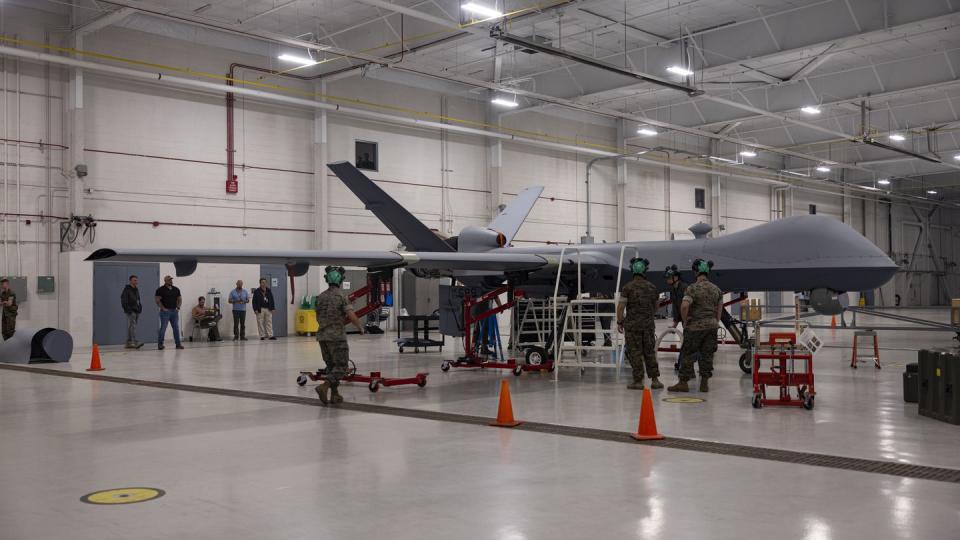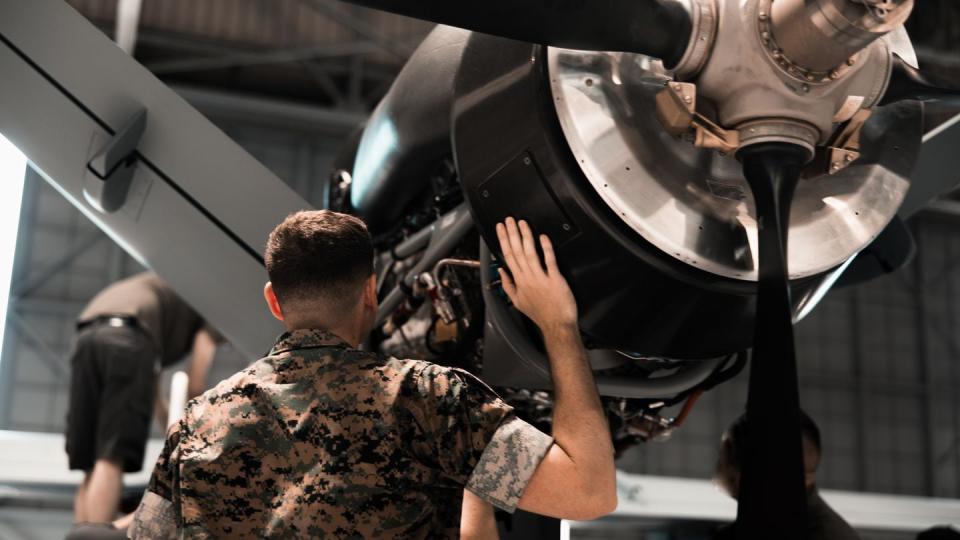As demand rises, Marines need their own school for MQ-9 drone crews
As the Marines grow their drone fleet, the Corps needs to begin training its own crews instead of relying on the Air Force, the top Marine said.
During budget testimony Tuesday before a subcommittee of the Senate Appropriations Committee, Sen. John Hoeven, (R-North Dakota), asked Marine Corps Commandant Gen. Eric Smith about the Corps’ needs for airborne intelligence, surveillance and reconnaissance assets.
“The MQ-9 is a vital platform,” Smith said. “We’re focused on the training and procurement of that end.”
The Corps has used the MQ-9A with contractor support since 2018 and began procuring its own MQ-9s and training its pilots through Air Force schools in 2021. As of December 2023, the Corps had 100 MQ-9A trained pilots. The Marine Corps has 10 MQ-9A drones in the fleet with another 10 scheduled for delivery by the end of fiscal year 2025.
But as the force grows, the Corps needs its own training pipeline to feed the fleet.
“We are currently working with the Air Force to train dually, but we need to stand up the schoolhouse as well, to pull some of that pressure off the Air Force,” Smith said.
In mid-April the Corps announced the assembly of the first MQ-9A at 2nd Marine Aircraft Wing at Cherry Point, North Carolina.

The Marine Corps operates its small drone training certification at the School of Infantry-East, Camp Geiger, North Carolina. The 71-day course teaches Marines to operate the VXE-30 Stalker, the R-80D Sky Raider and the RA-20 Puma, a Marine official said. All of which are group 2 drones, which weigh between 21 pounds and 55 pounds and fly below 2,500 feet.
Marines who earn the small unmanned aerial systems job code of 7316 can then train Marines in the fleet, often in infantry units.
The service first established MQ-9A units in Arizona and Hawaii to support operations under U.S. Indo-Pacific Command.
The Corps opted to focus on the older MQ-9A drone after Congress cut funding in 2018 for a more ambitious sea drone called the Marine Air Ground Task Force (MAGTF) Unmanned Expeditionary (MUX) Medium-Altitude, High-Endurance aircraft.
The MUX program, first announced in 2016, sought to use an aerial sea drone capable of landing and taking off from Navy ships that support Marine amphibious operations, such as helicopter carriers and ships with well decks for launching watercraft.
The MUX would contain electromagnetic warfare equipment, communications, command and control and strike capabilities. That package would allow the system to serve as a central node, coordinating between multiple platforms in the air on land and at sea and striking across vast distances.
Then-Deputy Commandant of Aviation Lt. Gen. Steven Rudder told U.S. Naval Institute in 2020 that the Marine Corps drone couldn’t get the endurance it needed for airborne early warning and communications relay using a a vertical takeoff design . That kind of design was required to use the drone on amphibious ships.
That forced the service to shift its efforts to splitting up the various capabilities it wanted in the MUX across multiple platforms, one of which is the RQ-9A.
“With a family of systems approach, my sense is we’re going to have an air vehicle that can do some of the requirements, some of the higher-end requirements, potentially from a land-based high-endurance vehicle, but we’re still going to maintain a shipboard capability, it just may not be as big as we originally configured,” Rudder said.
While the Marine Corps continues to experiment with the MUX concepts, it uses the MQ-9A with various payloads and pods to test the concept of coordinating Marine Air-Ground Task Force operations with joint partners.
The 3rd Marine Aircraft Wing procured the Corps’ first MQ-9 in August 2021. From 2018 to 2021, the Marines used contractors to operate leased drones.
In 2020 the service established the 7318 military occupational specialty for MQ-9 pilots. By 2022 the Corps had trained 38 drone pilots. In late December 2023 the service announced it had trained 100 pilots for the MQ-9.
Prior to the procurement, 3rd MAW’s Marine Unmanned Aerial Squadron-1 in Yuma, Arizona, transitioned from the RQ-21 Group 3 drone to the MQ-9A.
The squadron had operated the MQ-9, with contractors, to support operations in U.S. Central Command as early as 2018.

Marine Corps Times previously reported on work with MQ-9A support for Task Force Southwest, which operated out of Helmand Province, Afghanistan at the time.
Group 3 drones typically fly at altitudes below 18,000 feet and weigh between 55 pounds and 1,320 pounds. Group 5 drones, like the MQ-9, are heavier than 1,320 pounds and fly higher than 18,000 feet. The MQ-9 is the Corps’ first Group 5 drone.
The MQ-9 has a maximum takeoff weight of 10,500 pounds, with an external payload capacity of 3,000 pounds. The drone can fly a maximum distance of 2,250 nautical miles. It’s maximum flight time is 27 hours, according to Navy data.
The Air Force has operated the MQ-9 since 2007 and as of 2021 had more than 300 of them in its inventory.
In August 2023, Marine Unmanned Aerial Squadron-3 at Kaneohe Bay, Hawaii was the first squadron to reach initial operational capability.
The squadron operates the drones as an “airborne quarterback” for the 3rd Marine Littoral Regiment, Col. William Heiken, then commander of Marine Aircraft Group 24, said at the time.
The regiment is the Corps’ newest unit, designed to disperse Marines across vast distances, using sensing equipment to target enemy ships on behalf of the Navy.
The Marines procured the first of eight MQ-9s in May 2023 under a joint contract with the Air Force, according to a Naval Air Systems Command release.
*UPDATE: This article has been updated with the current numbers of fielded MQ-9A drones in the Marine Corps fleet.

